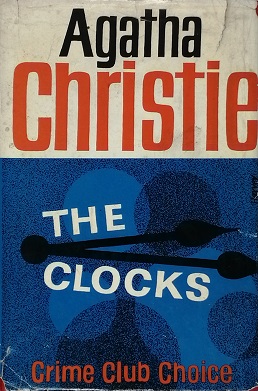The Clocks (novel)

Dust jacket illustration of the first UK edition
|
|
| Author | Agatha Christie |
|---|---|
| Cover artist | Michael Harvey |
| Country | United Kingdom |
| Language | English |
| Genre | Crime novel, Spy novel |
| Publisher | Collins Crime Club |
|
Publication date
|
7 November 1963 |
| Media type | Print (hardback & paperback) |
| Pages | 256 first edition, hardcover |
| Preceded by | The Mirror Crack'd from Side to Side |
| Followed by | A Caribbean Mystery |
The Clocks is a work of detective fiction by Agatha Christie and first published in the UK by the Collins Crime Club on 7 November 1963 and in the US by Dodd, Mead and Company the following year. It features the Belgian detective Hercule Poirot. The UK edition retailed at sixteen shillings (16/-) and the US edition at $4.50.
The novel is notable for the fact that Poirot never visits any of the crime scenes or speaks to any of the witnesses or suspects. He is challenged to prove his claim that a crime can be solved by the exercise of the intellect alone. The novel marks the return of partial first-person narrative, a technique that Christie had largely abandoned earlier in the Poirot sequence but which she had employed in the previous Ariadne Oliver novel, The Pale Horse (1961). There are two interwoven plots: the mystery Poirot works on from his armchair while the police work on the spot, and a Cold War spy story told in the first person narrative.
Sheila Webb, a typist at Miss Martindale's agency, arrives at her afternoon appointment at Wilbraham Crescent in Crowdean, Sussex. She finds a well-dressed stabbed corpse surrounded by six clocks, four of which are stopped at 4:13, while the cuckoo clock announces it is 3 o'clock. When a blind woman enters the house about to step on the corpse, Sheila runs screaming out of the house and into the arms of a young man passing down the street.
This man,Special Branch or MI5 agent Colin "Lamb", takes Sheila into his care. He is investigating a clue from a note found in a dead agent's pocket; letter M, number 61, and a sketch of a crescent moon written on a bit of hotel stationery (sketched in the book). At 19 Wilbraham Crescent, home of the blind Miss Pebmarsh, a police investigation begins into the murder. The dead man's business card proves false. His clothing reveals nothing else, as all labels have been removed. He was killed with an ordinary kitchen knife. Colin and Inspector Hardcastle interview the neighbours. Their homes adjoin the murder site on the street or from the back gardens in this unusually arranged Victorian housing development. Colin takes a liking to Sheila.
...
Wikipedia
